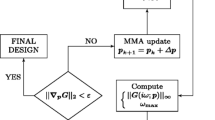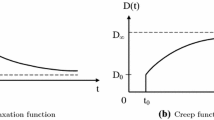Abstract
A novel frequency–based definition of dynamic compliance is introduced within the framework of H ∞ –norm based structural dynamics in the presence of load uncertainties. The system itself is supposed to depend on a vector of design parameters with respect to which an optimal design is pursued. A three-step worst-case-scenario is then developed that finds the minimum-compliance structure capable of accounting for the entire norm–bounded load sets. Once the problem is initialized, the current worst load is found that is used as input to the minimization of the structural compliance and the procedure is repeated until convergence. Numerical examples are eventually proposed that deal with viscoelastic beams discretized via a truly–mixed finite–element scheme.





































Similar content being viewed by others
References
Ang A, Tang W (1975) Probability Concepts in Engineering Planning and Design, Vol. 1: Basic Principles Wiley
Ang A, Tang W (1984) Probability Concepts in Engineering Planning and Design, Vol. 2: Decision, Risk, and Reliability. Wiley
Asadpoure A, Tootkaboni M, Guest J (2011) Robust topology optimization of structures with uncertainties in stiffness ? application to truss structures. Comput Struct 89:1131–1141
Ben-Haim Y, Elishakoff I (1990) Convex Models of Uncertainty in Applied Mechanics. Elsevier, New York NY
Bendsoe M, Sigmund O (1999) Material interpolation schemes in topology optimization. Arch Appl Mech 69(9–10):635–654
Bendsoe M, Sigmund O (2003) Topology optimization: Theory, methods and applications. Springer, Berlin
Boyd S, Balakrishnan V, Kabamba P (1989) A bisection method for computing the h ∞ norm of a transfer matrix and related problems. Math Control Signals Syst 2(3):207–219
Brittain K, Silva M, Tortorelli D (2012) Minmax topology optimization. Struct Multidiscip Optim 45:657–668
Bruggi M, Venini P (2008) A mixed fem approach to stress-constrained topology optimization. Int J Numer Methods Engrg 73:1693–1714
Bruinsma N, Steinbuch A (1990) A fast algorithm to compute the h ∞ norm of a transfer function matrix. Syst Control Lett 14(4):287–293
Chen S, Chen W, Sanghoon L (2010) Level set based robust shape and topology optimization under random field uncertainties. Struct Multidiscip Optim 41:507–524
Cherkaev E, Cherkaev A (2003) Principal compliance and robust optimal design. J Elast 72:71–98
Cherkaev E, Cherkaev A (2008) Minimax optimization problem of structural design. Comput Struct 86:1426–1435
Csebfalvi A (2016) Structural optimization under uncertainty in loading directions: Benchmark results. Advances in Engineering Software. doi:10.1016/j.advengsoft.2016.02.006
Diaz A, Bendsoe M (1992) Shape optimization of structures for multiple loading conditions using a homogenization method. Structural Optimization 4:17–22
Francis B (1987) A Course in H ∞ Control Theory Lecture notes in control and information sciences, vol 88. Springer-Verlag, Berlin, Heidelberg
Giesy DP, Lim KB (1993) H ∞ norm sensitivity formula with control system design applications. J Guid Control Dyn 16(6):1138–1145
Guest J, Igusa T (2008) Structural optimization under uncertain loads and nodal locations. Comput Methods Appl Mech Eng 198:116–124
Guo X, Bai W, Zhang W (2009) Confidence extremal structural response analysis of truss structures under static load uncertainty via sdp relaxation. Comput Struct 87(3–4):246–253
Guo X, Bai W, Zhang W, Gao X (2009) Confidence structural robust design and optimization under stiffness and load uncertainties. Comput Methods Appl Mech Eng 198 (41–44):3378– 3399
Guo X, Zhao X, Zhang W, Yan J, Sun G (2015) Multi–scale robust design and optimization considering load uncertainties. Comput Methods Appl Mech Eng 283:994–1009
Holmberg E, Thore CJ, Klarbring A (2015) Worst-case topology optimization of self-weight loaded structures using semi-definite programming. Struct Multidiscip Optim 52:915–928
Jensen JS, Nakshatrala PB, Tortorelli DA (2014) On the consistency of adjoint sensitivity analysis for structural optimization of linear dynamic problems. Struct Multidiscip Optim 49:831– 837
Kanno Y, Takewaki I (2006) Sequential semidefinite program for maximum robustness design of structures under load uncertainty. J Optim Theory Appl 130(2):265–287
Kharmanda G, Olhoff N, Mohamed A, Lemaire M (2004) Reliability-based topology optimization. Struct Multidiscip Optim 26:295–307
Pingaro M, Venini P (2016) A fast approach to analysis and optimization of viscoelastic beams. Comput Struct 168:46–55
Seyranian A, Lund E, Olhoff N (1994) Multiple eigenvalues in structural optimization problems. Structural Optimization 8:207– 227
Silva M, Tortorelli D, Norato J, HA C, Bae HR (2010) Component and system reliability-based topology optimization using a single-loop method. Struct Multidiscip Optim 41:87–106
Svanberg K (1987) The method of moving asymptotes - a new method for structural optimization. Int J Numer Methods Eng 24:359– 373
Takezawa A, Nii S, Kitamura M, Koguso N (2011) Topology optimization for worst load conditions based on the eigenvalue analysis of an aggregated linear system. Comput Methods Appl Mech Eng 200:2268–2281
Torii A, Novotny AA, dos Santos R (2016) Robust compliance topology optimization based on the topological derivative concept. International Journal for Numerical Methods in Engineering. doi:10.1002/nme.5144
Zhou M, Lazarov B, Sigmund O (2016) Topology optimization for optical microlithography with partially coherent illumination. International Journal for Numerical Methods in Engineering. doi:10.1002/nme.5299
Acknowledgments
Fondazione Cariplo (Grant Safer Helmets) is gratefully acknowledged. Professor Davide Raimondo of the University of Pavia is gratefully acknowledged for stimulating discussions on the topics of the paper.
Author information
Authors and Affiliations
Corresponding author
Rights and permissions
About this article
Cite this article
Venini, P., Pingaro, M. An innovative H ∞ –norm based worst case scenario approach for dynamic compliance optimization with applications to viscoelastic beams. Struct Multidisc Optim 55, 1685–1710 (2017). https://doi.org/10.1007/s00158-016-1605-0
Received:
Revised:
Accepted:
Published:
Issue Date:
DOI: https://doi.org/10.1007/s00158-016-1605-0




